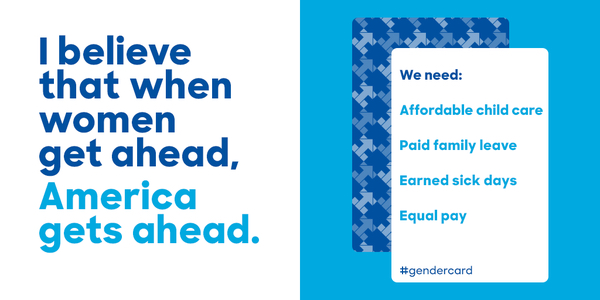Lesson 1: Every presidential candidate – man or woman – plays the gender card. They just do it differently.
 In April 2015, the Barbara Lee Family Foundation (BLFF) and the Center for American Women and Politics (CAWP) launched Presidential Gender Watch 2016, a project to track, analyze, and illuminate gender dynamics in the 2016 presidential election. With the help of expert scholars and practitioners, Presidential Gender Watch worked for 21 months to further public understanding of how gender influences candidate strategy, voter engagement and expectations, media coverage, and electoral outcomes in campaigns for the nation’s highest executive office. The blog below was written for Presidential Gender Watch 2016, as part of our collective effort to raise questions, suggest answers, and complicate popular discussions about gender’s role in the presidential race.
In April 2015, the Barbara Lee Family Foundation (BLFF) and the Center for American Women and Politics (CAWP) launched Presidential Gender Watch 2016, a project to track, analyze, and illuminate gender dynamics in the 2016 presidential election. With the help of expert scholars and practitioners, Presidential Gender Watch worked for 21 months to further public understanding of how gender influences candidate strategy, voter engagement and expectations, media coverage, and electoral outcomes in campaigns for the nation’s highest executive office. The blog below was written for Presidential Gender Watch 2016, as part of our collective effort to raise questions, suggest answers, and complicate popular discussions about gender’s role in the presidential race.
One year ago, the Center for American Women and Politics at Rutgers University and the Barbara Lee Family Foundation launched Presidential Gender Watch 2016, a nonpartisan project to track, analyze, and illuminate gender dynamics in the 2016 presidential election. The goal of the project was – and remains – to lend expert analysis to the dialogue around gender throughout the election season. With just over 200 days until Election Day, it’s worth taking stock of what we’ve been up to. Over the next week, we will post 5 key lessons learned. Today, we review lesson number one: Every presidential candidate – man or woman – plays the gender card. They just do it differently. (See hyperlinks for full analyses written over the past year.)

Last August, after Mitch McConnell argued that the “gender card alone is not enough” for Hillary Clinton to win the presidency, I argued, “all candidates ‘play the gender card’ in the ways in which they navigate gender norms and expectations in today’s campaigns.” I added, “For most of American history, that has meant that presidential candidates – male and female – have worked to prove they are ‘man enough’ for the job.” That performance of masculinity has been most apparent in the GOP race, where all candidates have engaged in tough talk and men have repeatedly described their roles as masculine protectors. For example, we wrote about the protectionist rhetoric inherent in a debate discussion over Syrian refugees, where moderator and candidates alike falsely described refugees as primarily male and a risk to vulnerable women. Donald Trump has repeatedly described himself as a protector of women (most recently last week), apparently taking some early advice from his daughter Ivanka to “let people know how much you adore women and how you’ll take care of them.”
Male candidates are not alone in performing masculinity; female presidential candidates also work hard to meet the masculine credentials expected of a commander-in-chief. They are equally capable of reinforcing gender norms in presidential campaigns, as some women have done when they remind political men to “man up.”
Another way that candidates elevate and empower masculinity is to devalue traits, experiences, or expertise associated with femininity. We have written about the politics of emasculation evident in this race, which has deep roots in electoral campaigning. This spring, the Trump-Rubio fights over size and stamina were among the most blatant attempts at emasculation. But these are not the only culprits or targets. Multiple Republican candidates denounced President Obama’s weakness, using language that simultaneously infantilized and emasculated him. Commentators have also weighed in, like when Rich Lowry claimed that Carly Fiorina “cut [Trump’s] balls off” at a September GOP debate. When candidates or commentators question women candidates’ toughness, stamina, or emotional stability to be president, they play into the same stereotypical expectations that maintain masculine ideals and associate femininity – and women – with weakness and, thus, inadequacy for being president.
Playing the gender card, then, means much more than talking about being a woman or targeting women voters. Recognizing the range of gender performance, and the ways in which candidates adhere to or disrupt gender expectations, provides a much richer analysis of gender in the presidential race. Of course, this type of analysis rejects the idea that gender “happens” to anyone, like when some have talked about Clinton or Fiorina as candidates who just “happen” to be women. Gender matters for women and men candidates, not only in what they bring to and experience in the campaign, but also in how they campaign and the ways in which they are perceived by election observers.


